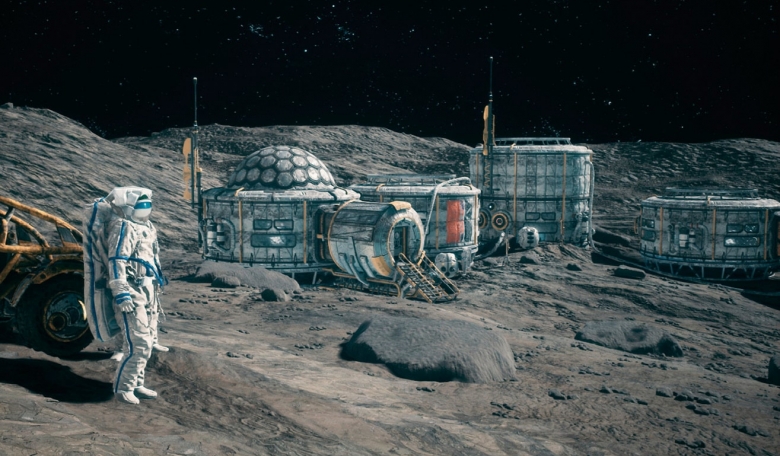Our understanding of the Moon has vastly increased since the 17th century when Dr John Wilkins first proposed the idea of colonising it. Today, with the development of additive manufacturing (AM), widely known as 3D printing, the concept of cost-effective lunar colonisation could soon become a reality. Here the authors consider what needs to be achieved before humans inhabit the Moon on a semi-permanent or permanent basis and explore all the opportunities it may have to offer from energy production and extraction of materials to easier space exploration – given that the best current estimate of ‘soon’ is eight years.
The concept of colonising the Moon predates humankind having even a basic knowledge of space, gravity and biological systems at both a pathway and molecular level. Contrary to the lack of scientific awareness at that point in history, the former Bishop of Chester and one of the founders of the Royal Society, Dr John Wilkins, first proposed the idea for colonising the moon after Johannes Kepler’s early telescopic observations of the lunar surface in his 1638 book, Discovery of a New World; or, A Discourse tending to Prove that ‘tis probable there may be another habitable World in the Moon.
The first stages of building a lunar base for colonists will, by necessity, involve equipment and consumables being brought from Earth. It is estimated that the cost for materials to be transported from Earth to the Moon will exceed US$100k per kilogram (kg) and this cost clearly precludes the establishment of any sustainable lunar infrastructure with all materials imported from Earth. Instead, such an infrastructure will require efforts for in situ resource utilisation (ISRU) to produce construction materials for hard landscaping of the habitat, surfaces to permit transportation to, from and on the Moon and material for shielding the inhabitants and their equipment, where the absence of an atmosphere and magnetic field demands protection from radiation exposure, temperature extremes, meteorite impact and lunar dust.
The concept of colonising the Moon predates humankind having even a basic knowledge of space, gravity and biological systems at both a pathway and molecular level
A design architecture must also support an acceptable quality of life for colonists where the construction of a sound habitat is of paramount importance for the maintenance of physical and mental fitness and for reinforcement of collaborative practice.
The first 3D equipment and materials were developed in the 1980s, starting with Hideo Kodama in 1981 who developed a layer-by-layer manufacturing approach with a photosensitive resin polymerised by UV light. Also in 1981, Charles Hull developed the commercial 3D printer using Stereolithography (SLA), a process which uses a computer-controlled moving laser beam, pre-programmed using computer aided manufacturing (CAM) and computer aided design (CAD).
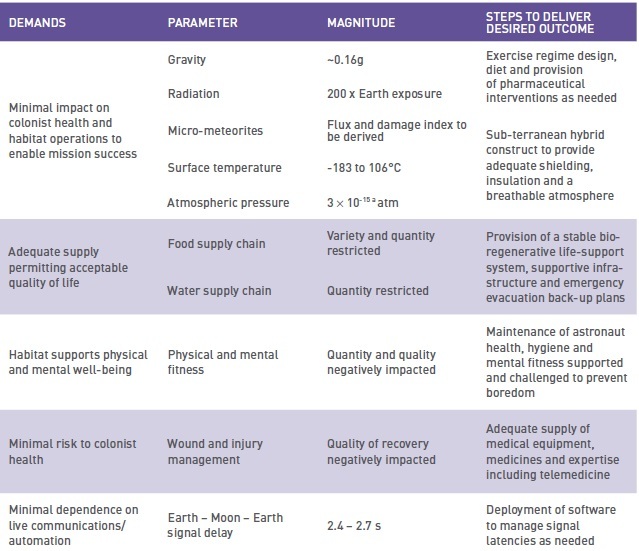 Conditions which must be accommodated to provide acceptable quality of life for lunar colonists.
Conditions which must be accommodated to provide acceptable quality of life for lunar colonists.
Throughout the mid-to-late 1980s, other AM approaches were being developed with Carl Deckard inventing Selective Laser Sintering (SLS) technology which fuses powders rather than a liquid by laser, and Scott Crump who first developed Fused Deposition Modelling (FDM) that uses a thermoplastic filament such as nylon or extremely strong polycarbonate which is heated to just above its melting point and then extruded in layers to produce a 3D prototype, this using heat rather than light. The awareness by the general public of FDM in the 2000s is credited with it being the most popular technique used today.
The world’s largest 3D printer was manufactured by Ingersoll Machine Tools in the USA and is capable of running along a 30 m bed and extruding printer filament at a rate of 226 kg per hour. This machine created the largest 3D printed structure: 3Dirigo - a full size patrol boat measuring 7.62 m long and weighing nearly 2000 kg.
Clearly, we can print large structures on Earth and we understand what problems will we face as colonists on the Moon. So what design considerations does 3D printing have to solve and how can we do it?
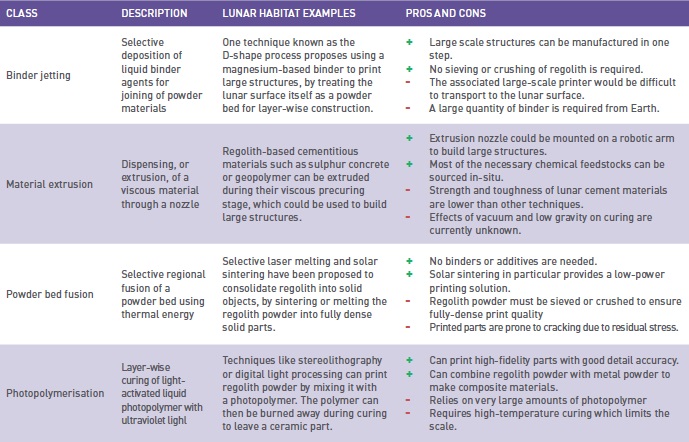 Classes of 3D printing technologies with applications for the lunar environment.
Classes of 3D printing technologies with applications for the lunar environment.
Lunar regolith
The first stages of building a lunar base for colonists will, by necessity, involve equipment and consumables being brought from Earth
The lunar surface comprises two types of terrain; the highland areas which are heavily cratered and the lunar lowlands which include the smooth maria, former craters that have flooded and filled with molten lava. The two most common kinds of rocks on the Moon are basalts and anorthosites. The lunar basalts are relatively rich in iron and also rich in titanium and are found in the maria, whereas in the highlands, the rocks are largely anorthosites and are relatively rich in aluminium, calcium, and silicon.
 Dr John Wilkins (left) and (right) the frontispiece to his A Discovery of a New World; or, A Discourse tending to Prove that ‘tis probable there may be another habitable World in the Moon, published in 1638.
Dr John Wilkins (left) and (right) the frontispiece to his A Discovery of a New World; or, A Discourse tending to Prove that ‘tis probable there may be another habitable World in the Moon, published in 1638.
The surface of the Moon is mostly covered with regolith, a mixture of fine dust and rocky debris mostly < 2x10-5 m in size produced by micro-meteorite impacts over billions of years. The mean thickness of the regolith covering the whole lunar surface varies from 4-5 m in the lunar maria to 10-15 m in the highlands. Lunar soil refers to only the finer fraction of regolith, which is composed of grains 1x10-2 m in diameter or less.
 Some of the founding figures of additive manufacturing, better known as 3D printing.
Some of the founding figures of additive manufacturing, better known as 3D printing.
Lunar dust generally refers to even finer materials than regolith and ranges from 1x10-6 - 1x10-4 m and the low conductance and electrostatic charge, coupled with reduced lunar gravity, permits greater airborne persistence when disturbed and causes the dust to adhere to many surfaces. As less than 400 kg of regolith was brought back to Earth from the Apollo missions, lunar regolith simulants (LRS) have been identified and characterised on Earth. These simulants possess many of the properties of authentic regolith and have been the source of most terrestrial-based studies, including those with 3D printing.
Since regolith is a heterogenous mixture of compounds, it melts over a temperature range of between 1100-1380C and is completely molten at temperatures greater than 1380C. The highest temperature that a filament in a 3D printer can reach is 3400C with a tungsten filament, making it viable for lunar manufacturing.
Various other 3D printing techniques are also available, each coming with a wide range of manufacturing approaches potentially amenable to a lunar scenario. The American Society for Testing and Materials (ASTM) International defines all 3D printing techniques as being one of seven classes: binder jetting, direct energy deposition, material extrusion, powder bed fusion, sheet lamination, vat polymerisation and material jetting.
Each class brings different advantages and can accommodate different materials, scales, morphologies and environments. For extra-terrestrial contexts, there have been recent developments in four of these seven classes, whereby materials and structures originating from regolith could be produced using 3D printing.
 Large 3D printed structures; the 3Dirigo constructed at the Unversity of Maine, and a 1500 kg building block printed from LRS by ESA and Foster + Partners. The hollow closed-cell structure is similar in concept to terrestrial breeze blocks providing a combination of strength and weight.
Large 3D printed structures; the 3Dirigo constructed at the Unversity of Maine, and a 1500 kg building block printed from LRS by ESA and Foster + Partners. The hollow closed-cell structure is similar in concept to terrestrial breeze blocks providing a combination of strength and weight.
Pilot studies
Regolith is a heterogenous mixture of compounds, it melts over a temperature range of between 1100-1380C and is completely molten at temperatures greater than 1380C
Many pilot studies have been published on the topic. For the RegoLight project (part of the European Union’s Horizon 2020 Programme), a German research team in collaboration with ESA assessed the feasibility of sintering lunar regolith layer by layer to fabricate bricks using only concentrated sunlight.
During this study terrestrial atmospheric fluctuations induced variations in flux density leading to inhomogeneous sintering of individual layers, however this challenge may not apply on the Moon, which essentially has no atmosphere and variations in flux density should be minimal.
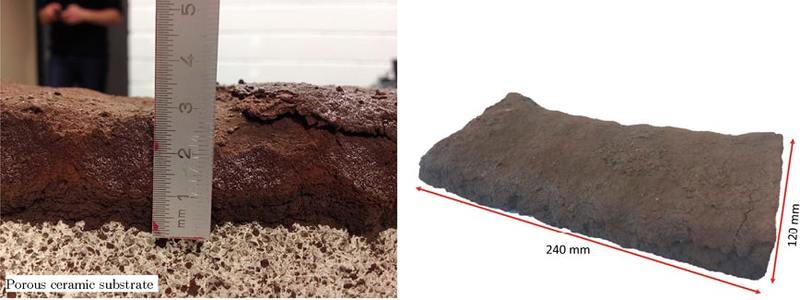 Cross-sectional and plan of a 3D printed brick using JSC-2A LRS in a solar simulator. The part was sintered on top of a porous substrate which could then be removed. Typical fabrication times range between 30 - 225 minutes for small constructs. A. Meurisse, A. Makaya, C. Willsch, M. Sperl, Solar 3D printing of lunar regolith, Acta Astronautica, Volume 152, 2018.
Cross-sectional and plan of a 3D printed brick using JSC-2A LRS in a solar simulator. The part was sintered on top of a porous substrate which could then be removed. Typical fabrication times range between 30 - 225 minutes for small constructs. A. Meurisse, A. Makaya, C. Willsch, M. Sperl, Solar 3D printing of lunar regolith, Acta Astronautica, Volume 152, 2018.
This study is one important first step as it demonstrates feasibility and informs on areas for improvement, which include increasing compression strength and optimisation of interlayer bonding and cooling cycles between layer deposition; the latter will be crucial in reducing thermal stress by ensuring even temperature distribution between layers. A large number of projects have been instigated around the globe to determine technological feasibility of 3D printing in space.
In 2021, another German research team successfully 3D printed lunar regolith for the first time under zero gravity replicated on Earth in the Einstein elevator. Project MOONRISE used a customised laser mounted on the MIRA3D lunar rover prototype and melted regolith into spherical shapes.
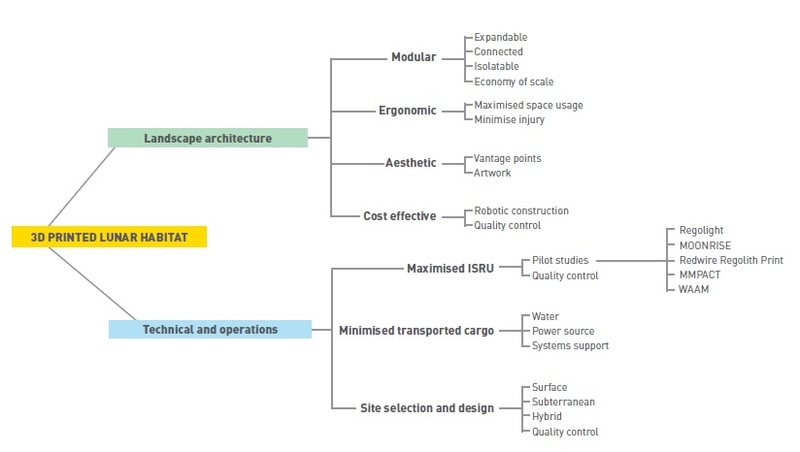 Mind map for construction of a 3D printed lunar habitat. Themes are clustered under landscape architecture and technical and operations.
Mind map for construction of a 3D printed lunar habitat. Themes are clustered under landscape architecture and technical and operations.
The Redwire Regolith Print study aims to demonstrate manufacturing on board the International Space Station (ISS) using a process similar to fused deposition; the study will use a feedstock of metal oxides and a binder LRS to 3D print multiple plates which will be brought back to Earth for analysis. NASA’s Moon-to-Mars Planetary Autonomous Construction Technology (MMPACT) project aims to develop an understanding of resources needed to deliver an on-demand capability for establishment of a lunar base; an early projection of lunar regolith materials needed for a 30 m diameter landing pad was estimated at several thousand kilograms.
What design considerations does 3D printing have to solve and how can we do it?
Wire arc additive manufacturing (WAAM) is a promising technology for producing larger components with moderate complexity, such as stiffened panels which may be utilised in spacecraft to support and shield solar concentrators, and thermal generators, though this technique would clearly depend upon a source of metal wire which would need to be imported from Earth as a primer and then extracted from regolith over the long term.
Although 3D printing is no longer in its infancy, the application of the technology to print constructs on the Moon in situ is at a very early stage and current areas for improvement are broad and complex. Such areas include reduction of the high demand for consumables delivered from Earth, potential low mechanical strength and high anisotropy of printed parts, high energy demand for 3D printers, unknown tolerance to wide temperature range and fluctuation, low-gravity performance, and low understanding of regolith property variation across the lunar surface, specifically of how this affects manufacturing.
Although the ambition is to construct the habitat in situ, a basic inventory of starting materials will need to be imported from Earth and this includes the initiating 3D printers, material excavation and beneficiation systems, solar arrays, power provision infrastructure, and sufficient water and raw substances to prime the manufacturing systems for readiness and construct production.
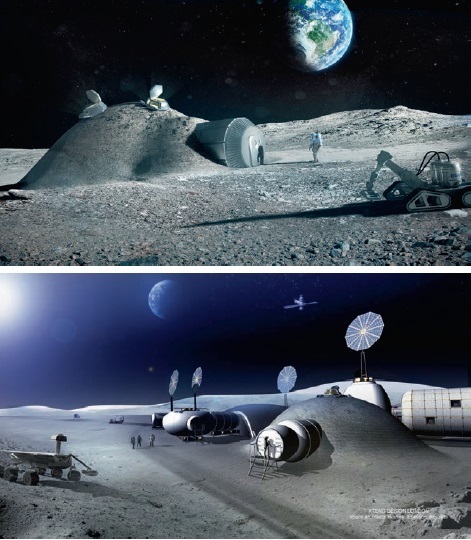 Design concepts for hybrid lunar habitats incorporating 3D printing techniques.
Design concepts for hybrid lunar habitats incorporating 3D printing techniques.
Design architecture
Design considerations for an initial installation need to take into account a likely future-proofed architecture capable of supporting tens or even hundreds of lunar colonists. The landscape architecture should be modular, with adequate capacity for inhabitants and with the capability to be isolatable in case of emergency. An expandable design with off-the-shelf modules would leverage economy of scale and be envisioned as built by robotics with human oversight of quality control which would ensure cost-effectiveness and maintain an acceptable benefit-to-risk ratio for human habitation.
Human factors and aesthetic design are essential considerations for optimisation of both mental and physical fitness and should maximise the available space while minimising the risk of incidents and accidents. Siting of the colony is crucial, as is the topology with respect to the lunar surface.
The most likely location for a lunar base will be at or near the poles. At the south pole there is Shackleton crater, which at the rim is in almost permanent sunlight, potentially providing near continuous incident solar power and requiring fewer solar arrays than sites where the availability of sunlight is more restricted. At the north pole, Peary crater provides a similar environment and at both poles there is believed to be frozen water in the crater shadow regions which may provide a source for a liquid water supply chain.
With one of the major roles of a lunar colony being to provide shielding from cosmic and solar radiation, micrometeorites and extremes of temperature, site design options include fully surface or fully subterranean habitats, for example, in lava tubes. The current proposals favoured by most space agencies include the ESA designed hybrid approach, where the colony module is surface located and cocooned in a protective layer of lunar regolith.
Personal space
The application of the technology to print constructs on the Moon in situ is at a very early stage and current areas for improvement are broad and complex
Our simple and idealistic design feature, where each colonist is provided with an autonomous environment may at first sight appear overly generous, however, the importance of personal space for human beings has long been recognised as an innate requirement and has been termed the ‘invisible second skin’.
The need for personal space has been demonstrated in many areas where both working and living conditions are confined, for example, in submarines where the confinement, isolation, and stress that is characteristic of the environment creates a psychological need for more room and a sense of privacy and this need becomes more important for longer missions.
Three general reasons why humans need their own personal space relate to; reducing the potential for sensory overload; protection from potential aggression and, ultimately, stress; and non-verbal behaviours such as eye contact and body orientation which we use to control the type of message we want to communicate with others. This design feature for colony architecture is a prerequisite for building a team environment which will survive by collaboration, recognition and acknowledgement of individual contribution while providing necessary moments for isolation and self-reflection.
In 2021 the requirement for maintenance of personal space of both humans and human-like avatars was modelled by Dr Roger Tootell at Harvard Medical School and it was reported that discomfort-by-distance functions for both humans and avatars were closely aligned in a power relationship. This reinforces the notion that humans need personal space not just from other humans, but may also need space from human-like objects which could become important for future design of humanoid robots.
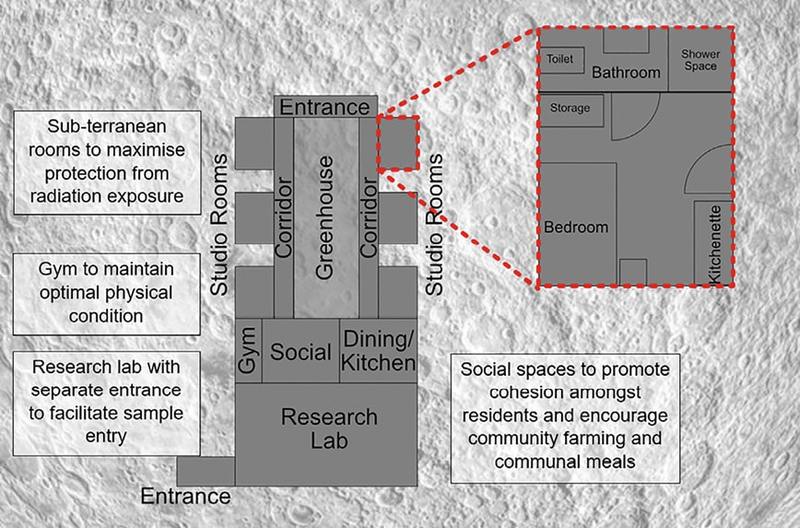 Conceptual design of a modular lunar habitat, architecture for multiple modules and a simple floor plan with provision of personal space supporting colonist long term habitation.
Conceptual design of a modular lunar habitat, architecture for multiple modules and a simple floor plan with provision of personal space supporting colonist long term habitation.
Solar concentrators
On Earth, solar concentrators have been used to successfully demonstrate a number of ISRU requirements including sintering of regolith with the aim of producing infrastructure and building blocks for construction, and the extraction of hydrogen, oxygen and water as raw commodities. Terrestrial solar concentrators are heavy, not designed for shipping, assembly and installation in hostile environments and require servicing to maintain continuous performance.
For lunar deployment, space agencies will need to provide low mass, low volume equipment which can be easily deployed, is able to track the Sun, and can perform self-cleaning operations to remove accumulated dust. To sinter regolith, concentrators are required to acquire and maintain a high focal point temperature of up to 1380C and traverse the regolith at 1x10-3 - 1x10-2 m s-1.
A second batch of automated equipment of fixed position thermal reactors will receive directed solar energy from the concentrators to extract metals in addition to hydrogen, oxygen and water, and/or sinter regolith. All components need to function at extreme temperatures. One route to mitigate this requirement at least in part is to site equipment at a polar crater rim in near constant sunlight, and away from shadows where the temperature can be as low as -180C and a crater rim location also avoids the wide day/night fluctuation reported in lunar equatorial regions.
Human factors and aesthetic design are essential considerations for optimisation of both mental and physical fitness
Fast forward into a future when we have the protective exterior of our pre-fabricated lunar base established with lunar-sourced material. Design considerations will need to facilitate parallel construction of an inner sealed shell which will accommodate a bio-regenerative life-support system (BLSS), a closed artificial ecosystem to provide a sustainable basic atmosphere, food and water supply chain and waste management procedures.
Numerous terrestrial analogues have been built and tested in Europe, the USA and Asia and progress has been shown for improving the efficiency of plant cultivation, hydroponics, animal protein production, micro-algal and lettuce production of oxygen and carbon dioxide to gaseous homeostasis, water recycling, recovery of nitrogen from urine, and bioconversion of solid wastes into soil-like structures.
In 2021, China’s Yuegong-1 (Lunar Palace) study was one of the latest analogues to publish findings, describing a study conducted over 370 days duration with four people. Reporting a system closure degree of 98.2 percent - where 100 percent represents a fully autonomous unit – 100 percent of water was recycled, recovery of nitrogen from urea was 99.7 percent efficient and microbial waste degradation rate of solid waste was 67 percent.
This and other studies show great promise for increasing human ISRU and whether practiced on the Moon or implemented judiciously back on Earth, represent an exciting period for further scientific study and may one day, live up to John Wilkins’ prediction of 384 years ago!
Editor’s note
One of ROOM’s goals within the space community is to encourage and provide a forum for young authors who are embarking on a space career. For this article, STEM ambassador Martin Braddock, who works with and inspires young people to consider and further their scientific careers, coordinated four young people - Leia, Jake, Bee and Hannah - who are all studying towards careers that will be directly or indirectly connected to space.
About the authors
Leia Flinders is currently studying physics, chemistry, maths and further maths at Heanor Gate Spencer Academy in Derbyshire, UK. She has a strong passion for astronomy and physics as a whole and hopes to pursue physics at university.
Jake Grainger is studying mathematics, physics, chemistry and biology at Heanor Gate Spencer Academy in Derbyshire, UK. He has a strong interest in science and, in particular, medical sciences, and aspires to pursue medicine at university.
Hannah Clark is a Landscape Architect and is currently studying for her Master’s Degree in Landscape Architecture and Design at Leeds Beckett University, UK. She holds a BA in Landscape Architecture from Leeds Beckett, has a keen interest in designing spaces and communities that are beneficial to people’s health and wellbeing. During school and sixth form she studied physics and developed an interest in Astronomy which has followed her into adulthood. She intends to advance further in her career as a landscape architect by starting her pathway to chartership once finishing her current studies.
Bee Rich is a materials engineer and science communicator. She holds a Master of Engineering Degree from the University of Birmingham, UK and was a recent member of the European Space Agency’s Advanced Concepts Team, where she published research on topics relating to lunar habitats and off-Earth manufacturing. She is passionate about materials science and the role it will play in sustainable space exploration, and regularly participates in outreach events encouraging young people to engage with space topics. Later in 2022 Bee will commence her PhD studies with Swinburne University, Melbourne, Australia investigating lunar metal casting technologies for the future of in situ resource utilisation.
Martin Braddock is a scientist and project leader in the UK. He has published over 190 articles in many journals including Nature, Cell, Human Gene Therapy and Nature Drug Discovery and more recently, papers in astronomical journals where astronomy forms a passionate part of his life. He is a member of Sherwood Observatory, a Fellow of the Royal Astronomical Society (RAS) and a Fellow of the Royal Society of Biology. Martin is dedicated to inspiring young people to enter science, is an Advisory Council member at Filling Space and a STEM ambassador in the UK. He has given over 100 lectures to Astronomy Societies and student groups across the globe and in 2021 was nominated for the RAS Annie Maunder Outreach Medal.





